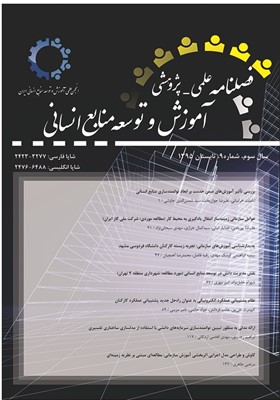ارائه مدلی به منظور تبیین توانمندسازي سرمايه¬هاي دانشي با استفاده از مدلسازی ساختاری تفسیری
محورهای موضوعی :ابراهیم رجب پور 1 , مهدی افخمی اردکانی 2
1 - دانشگاه تهران
2 - دانشگاه صنعت نفت
کلید واژه: توانمندسازی, سرمایه¬, های دانشی, مدلسازی ساختاری تفسیری, پژوهشگاه صنعت نفت,
چکیده مقاله :
با ظهور اقتصاد دانشی، قابلیت های انسانی به عنوان مهمترین مزیت رقابتی پایدار و منحصربهفرد برای سازمانها در محیط های متلاطم امروزی شناخته شده است؛ بنابراین، توجه به دانش و مهارت منابع انسانی و توانمندسازي این سرمایه های بی بدیل در سازمان ها و به خصوص در این دوران امری ضروری و غیرقابل انکار است. هدف از انجام این پژوهش شناسایی عوامل تأثیرگذار بر توانمندسازي سرمايه هاي دانشي و در نهایت ارائه الگویی در پژوهشگاه صنعت نفت با استفاده از تکنیک مدلسازی ساختاری تفسیری در این راستا است. با بررسی های صورت گرفته از مرور ادبیات تحقیق به روش تطبیقی، هشت دسته عوامل تبیین توانمندسازي در پژوهشگاه صنعت نفت شناسایی شده و سپس با استفاده از روش مدل سازي ساختاري تفسیری در پنج سطح، قرار گرفتند. در ادامه پس از مشخص شدن سطوح هر کدام از عوامل و همچنین با در نظر گرفتن ماتریس در دسترسپذیری نهایی، مدل نهایی ساختار تفسیری ترسیم گردید. نتایج نشان داد عاملهایی همچون آموزش و توسعه، ویژگی های شخصیتی، ساختار سازمانی و ماهیت شغل در ارتباط با موضوع توانمندسازي در پژوهشگاه صنعت نفت از اثرپذیری بیشتری نسبت به بقیه عوامل برخوردارند.
With the emergence of the knowledge economy, human capabilities known as the most unique and sustainable competitive advantage for organizations in the current rapidly changing environment. Therefore, in this period it is essential and undeniable to paying special attention in the knowledge and skills of human resources and empowerment of these unmatched capitals in organizations. The aim of this study was to identify factors influencing the empowerment of knowledge capitals and ultimately provide a model for Research Institution of Petroleum Industry, using interpretative structural modeling. With comprehensive review of the literature, eight factors were identified to explain the empowerment of the Petroleum Industry Research; then using interpretation of structural modeling, factors graded at five levels. Then, after determining the levels each of the factors and taking into account the availability of the final matrix, the final model of interpretation were drawn. The results showed that factors such as training and development, characteristics of personality, organizational structure and the nature of the job effect more than other factors in relation to empowerment in Research Institute of Petroleum Industry.
